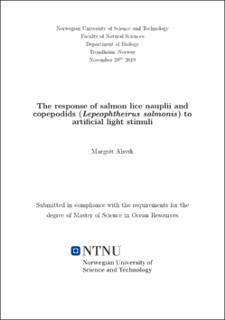| dc.contributor.advisor | Olsen, Rolf E. | |
| dc.contributor.advisor | Båtnes, Anna S. | |
| dc.contributor.advisor | Guttu, Maria | |
| dc.contributor.advisor | Reitan, Kjell I. | |
| dc.contributor.author | Alsvik, Margrét | |
| dc.date.accessioned | 2020-06-04T16:00:38Z | |
| dc.date.available | 2020-06-04T16:00:38Z | |
| dc.date.issued | 2019 | |
| dc.identifier.uri | https://hdl.handle.net/11250/2656636 | |
| dc.description.abstract | Lakselus (Lepeophtheirus salmonis) er sykdomsfremkallende ektoparasitter av atlanterhavslaks (Salmo salar), og anses som en av de fremste truslene mot oppdrettede og ville populasjoner av laksefisk. Parasitten er en av hovedbegrensningene for vekst innen akvakultur av laksefisk i Norge, og de årlige kostnadene assosiert med bekjemping og forebygging av lakselusangrep er høye. Lakseluslarver kan oppdage og respondere på fysiske og kjemiske signaler i det eksterne miljøet, og adferd relatert til slike signaler er ofte forbundet med lokalisering av potensielle verter.
Akvakulturindustrien benytter seg av undervannslys i merder for å forsinke seksuell modning og øke vekst hos atlanterhavslaks. Lys er kjent for å utløse vertikal døgnmigrasjon hos lakselus og forårsaker en positiv fototaksis hos larvene, og det er derfor mulig at nåværende praksis med kunstig belysning i lakseoppdrett kan påvirke konsentrasjonen av lakseluslarver inne i merder. For å undersøke dette ble det gjennomført et feltforsøk, hvor planktonprøver ble samlet inn inne i en merd samtidig som omgivelseslyset ble manipulert med en undervannslampe. Prøver ble samlet inn når det var dagslys (DH), uten kunstig belysning, og når det var mørkt/tussmørkt (DTH), med kunstig belysning. Det ble ikke funnet noen statistisk signifikant forskjell av luselarveinnhold i prøvene som ble samlet inn når det var DH eller DTH (p > 0.05), og ingen konklusjon som gjelder effekten av kunstig lys kunne dras.
For å begrense eksterne faktorer som påvirker responsen til lakseluslarver ble et laboratorieforsøk gjennomført på nauplii av to ulike lakseluslinjer (Ls Gulen og Wild) og på Ls Gulen kopepoditter. Nauplii ble eksponert for 3 ulike lysstimuli (blå/grønt, hvitt, fiolett), kopepoditter for 5 (blå/grønt, hvitt, fiolett, lavintensitets hvit, høyintensitets fiolett). Kontrolleksperimenter, uten lys, ble gjennomført for alle larver. Det ble funnet forskjeller i lysrespons mellom Ls Gulen og Wild nauplii: Ls Gulen nauplii hadde en økt respons på blå/grønt og hvitt lys, mens Ls Wild nauplii ikke responderte på noen av lysbehandlingene. Kontrasterende respons som ble avdekket kan komme av ulike oppdrettsforhold, men kan også skyldes genetiske forskjeller. Ls Gulen kopepoditter hadde en økt respons til begge de fiolette behandlingene. Bruk av fiolett lys i merder kan derfor muligens tiltrekke kopepoditter til oppdrettsanlegg, men partikler i sjøvann absorberer vanligvis fiolett lys og hindrer at det forplanter seg over store distanser. | |
| dc.description.abstract | Salmon lice (Lepeophtheirus salmonis) are ectoparasitic copepods that cause disease in maricultured Atlantic salmon (Salmo salar) and are considered one of the greatest threats to farmed and wild populations of salmonids. The parasite has become a key constraint to the continued growth of the salmonid aquaculture industry in Norway, and the annual cost of preventing and combating salmon lice infestations is high. Salmon lice larvae can detect and respond to physical and chemical cues in their external environment, and behaviour related to such cues is often associated with host-finding.
The aquaculture industry utilizes underwater lights in sea cages to delay sexual maturation and increase growth of Atlantic salmon. Light is known to trigger diurnal vertical migration in salmon lice and elicit a positive phototaxis. It is possible that current practices with artificial light in salmonid fish farms influence the concentration of salmon lice larvae inside sea cages. In this context, a field experiment where plankton samples were collected inside a sea cage, while manipulating the ambient light field with an underwater lamp, was conducted. Samples were collected during daylight hours (DH), without artificial light, and during darkness/twilight hours (DTH), with artificial light. No statistically significant difference between larval content of samples collected during DH and DTH was found (p > 0.05), and no conclusion regarding the effect of artificial light could be drawn.
To narrow down external factors influencing the response of salmon lice larvae, laboratory experiments were carried out on two different strains of nauplii (Ls Gulen and Wild) and on Ls Gulen copepodids. Nauplii were exposed to 3 different light stimuli (blue/green, white, violet), copepodids to 5 (blue/green, white, violet, low intensity white, high intensity violet). Control experiments, without light, were conducted for all larvae. Differences in response were found between Ls Gulen and Ls Wild nauplii: Ls Gulen nauplii had an increased response to blue/green and white light, while Ls Wild nauplii showed no significant response to any of the treatments. The contrasting response of the two nauplii strains could be due to different rearing conditions, but could also be explained by genetic dissimilarities between lice strains. Ls Gulen copepodids had an increased response to both violet light treatments. Use of violet light in sea cages could potentially attract copepodids to fish farms, however, absorption by particles in seawater usually impede violet light from propagating over great distances. | |
| dc.language | eng | |
| dc.publisher | NTNU | |
| dc.title | The response of salmon lice nauplii and copepodids (Lepeophtheirus salmonis) to artificial light stimuli | |
| dc.type | Master thesis | |
